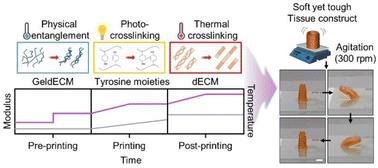当前位置:
X-MOL 学术
›
Biomater. Sci.
›
论文详情
Our official English website, www.x-mol.net, welcomes your feedback! (Note: you will need to create a separate account there.)
Tissue-specific gelatin bioink as a rheology modifier for high printability and adjustable tissue properties
Biomaterials Science ( IF 6.6 ) Pub Date : 2024-03-19 , DOI: 10.1039/d3bm02111d Hohyeon Han 1 , Minji Kim 2 , Uijung Yong 3 , Yeonggwon Jo 1 , Yoo-mi Choi 4 , Hye Jin Kim 5 , Dong Gyu Hwang 4 , Dayoon Kang 2, 4 , Jinah Jang 2, 4, 5, 6
Biomaterials Science ( IF 6.6 ) Pub Date : 2024-03-19 , DOI: 10.1039/d3bm02111d Hohyeon Han 1 , Minji Kim 2 , Uijung Yong 3 , Yeonggwon Jo 1 , Yoo-mi Choi 4 , Hye Jin Kim 5 , Dong Gyu Hwang 4 , Dayoon Kang 2, 4 , Jinah Jang 2, 4, 5, 6
Affiliation

|
Decellularized extracellular matrix (dECM) has emerged as an exceptional biomaterial that effectively recapitulates the native tissue microenvironment for enhanced regenerative potential. Although various dECM bioinks derived from different tissues have shown promising results, challenges persist in achieving high-resolution printing of flexible tissue constructs because of the inherent limitations of dECM's weak mechanical properties and poor printability. Attempts to enhance mechanical rigidity through chemical modifications, photoinitiators, and nanomaterial reinforcement have often compromised the bioactivity of dECM and mismatched the desired mechanical properties of target tissues. In response, this study proposes a novel method involving a tissue-specific rheological modifier, gelatinized dECM. This modifier autonomously enhances bioink modulus pre-printing, ensuring immediate and precise shape formation upon extrusion. The hybrid bioink with GeldECM undergoes a triple crosslinking system—physical entanglement for pre-printing, visible light photocrosslinking during printing for increased efficiency, and thermal crosslinking post-printing during tissue culture. A meticulous gelatinization process preserves the dECM protein components, and optimal hybrid ratios modify the mechanical properties, tailoring them to specific tissues. The application of this sequential multiple crosslinking designs successfully yielded soft yet resilient tissue constructs capable of withstanding vigorous agitation with high shape fidelity. This innovative method, founded on mechanical modulation by GeldECM, holds promise for the fabrication of flexible tissues with high resilience.
中文翻译:

组织特异性明胶生物墨水作为流变改性剂,具有高可打印性和可调节的组织特性
脱细胞细胞外基质(dECM)已成为一种特殊的生物材料,可有效重现天然组织微环境,增强再生潜力。尽管源自不同组织的各种 dECM 生物墨水已显示出有希望的结果,但由于 dECM 机械性能弱和可打印性差的固有限制,实现柔性组织结构的高分辨率打印仍然存在挑战。通过化学修饰、光引发剂和纳米材料增强来增强机械刚性的尝试往往会损害 dECM 的生物活性,并且与目标组织所需的机械性能不匹配。为此,本研究提出了一种涉及组织特异性流变改性剂——糊化 dECM 的新方法。该改性剂可自主增强生物墨水预打印模量,确保挤出时立即形成精确的形状。采用 GeldECM 的混合生物墨水经历了三重交联系统:预打印时的物理缠结、打印期间的可见光光交联以提高效率以及组织培养期间的热交联后打印。细致的糊化过程保留了 dECM 蛋白质成分,最佳的混合比例改变了机械性能,使其适合特定的组织。这种顺序多重交联设计的应用成功地产生了柔软而有弹性的组织结构,能够承受剧烈搅拌并具有高形状保真度。这种基于 GeldECM 机械调制的创新方法有望制造具有高弹性的柔性组织。
更新日期:2024-03-19
中文翻译:

组织特异性明胶生物墨水作为流变改性剂,具有高可打印性和可调节的组织特性
脱细胞细胞外基质(dECM)已成为一种特殊的生物材料,可有效重现天然组织微环境,增强再生潜力。尽管源自不同组织的各种 dECM 生物墨水已显示出有希望的结果,但由于 dECM 机械性能弱和可打印性差的固有限制,实现柔性组织结构的高分辨率打印仍然存在挑战。通过化学修饰、光引发剂和纳米材料增强来增强机械刚性的尝试往往会损害 dECM 的生物活性,并且与目标组织所需的机械性能不匹配。为此,本研究提出了一种涉及组织特异性流变改性剂——糊化 dECM 的新方法。该改性剂可自主增强生物墨水预打印模量,确保挤出时立即形成精确的形状。采用 GeldECM 的混合生物墨水经历了三重交联系统:预打印时的物理缠结、打印期间的可见光光交联以提高效率以及组织培养期间的热交联后打印。细致的糊化过程保留了 dECM 蛋白质成分,最佳的混合比例改变了机械性能,使其适合特定的组织。这种顺序多重交联设计的应用成功地产生了柔软而有弹性的组织结构,能够承受剧烈搅拌并具有高形状保真度。这种基于 GeldECM 机械调制的创新方法有望制造具有高弹性的柔性组织。



























 京公网安备 11010802027423号
京公网安备 11010802027423号